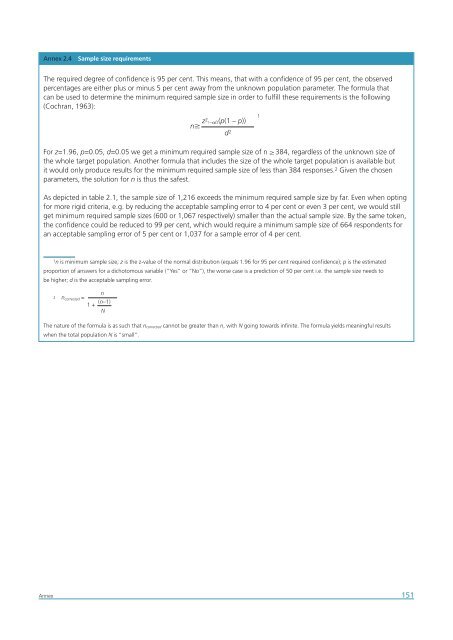Africa Foreign Investor Survey 2005 - unido
Africa Foreign Investor Survey 2005 - unido
Africa Foreign Investor Survey 2005 - unido
You also want an ePaper? Increase the reach of your titles
YUMPU automatically turns print PDFs into web optimized ePapers that Google loves.
Annex 2.4<br />
Sample size requirements<br />
The required degree of confidence is 95 per cent. This means, that with a confidence of 95 per cent, the observed<br />
percentages are either plus or minus 5 per cent away from the unknown population parameter. The formula that<br />
can be used to determine the minimum required sample size in order to fulfill these requirements is the following<br />
(Cochran, 1963):<br />
n z2 1–/2(p(1 – p))<br />
For z=1.96, p=0.05, d=0.05 we get a minimum required sample size of n 384, regardless of the unknown size of<br />
the whole target population. Another formula that includes the size of the whole target population is available but<br />
it would only produce results for the minimum required sample size of less than 384 responses. 2 Given the chosen<br />
parameters, the solution for n is thus the safest.<br />
d 2<br />
As depicted in table 2.1, the sample size of 1,216 exceeds the minimum required sample size by far. Even when opting<br />
for more rigid criteria, e.g. by reducing the acceptable sampling error to 4 per cent or even 3 per cent, we would still<br />
get minimum required sample sizes (600 or 1,067 respectively) smaller than the actual sample size. By the same token,<br />
the confidence could be reduced to 99 per cent, which would require a minimum sample size of 664 respondents for<br />
an acceptable sampling error of 5 per cent or 1,037 for a sample error of 4 per cent.<br />
1<br />
1 n is minimum sample size; z is the z-value of the normal distribution (equals 1.96 for 95 per cent required confidence); p is the estimated<br />
proportion of answers for a dichotomous variable (“Yes” or “No”), the worse case is a prediction of 50 per cent i.e. the sample size needs to<br />
be higher; d is the acceptable sampling error.<br />
2<br />
n<br />
n corrected =<br />
1 + (n–1)<br />
N<br />
The nature of the formula is as such that n corrected cannot be greater than n, with N going towards infinite. The formula yields meaningful results<br />
when the total population N is “small”.<br />
Annex<br />
151
















